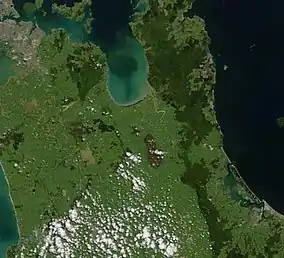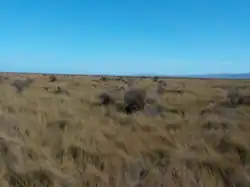Kopuatai Peat Dome
The Kopuatai Peat Dome is a large peatland complex located in the North Island of New Zealand and consists of two raised domes, one in the north the other in the south. These are up to three meters higher at the center than at the edge.[2] The 10,201 hectares (25,210 acres) wetland contains the largest intact raised bog in New Zealand and was listed under the Ramsar Convention in 1989 as a Wetland of International Importance.[3] Most of the wetland is 'ombrotrophic' meaning it receives water and nutrient inputs solely from rain and is hydrologically isolated from the surrounding canals and rivers.[4] Locally, a popular misconception persists that water flows from the nearby Piako River into the bog and that the wetland acts as a significant store for floodwater.[5]
| Kopuatai Peat Dome | |
|---|---|
 Kopuatai Peat Dome - the brown footprint-shaped area centre | |
| Location | North Island, New Zealand |
| Area | 10,201 hectares (25,210 acres) |
| Designated | 4 December 1989 |
| Reference no. | 444[1] |
History of the wetland
Kopuatai has survived extensive draining of the wetlands on the Hauraki Plains and was given protection in 1987 when it came under the administration of the newly formed Department of Conservation.[6]
Scientific and Conservation value

Kopuatai is one of only three sites to contain the plant Sporadanthus ferrugineus a formally widespread but now rare peatforming plant found only in the upper north island of New Zealand.[7] S. ferrugineus in turn provides the only known food source for a rare endemic moth Houdinia flexilissima known as 'Fred the thread' described as recently as 2006 and remarkable for being the thinnest caterpillar in the world[8] a number of other undescribed insect species are thought to inhabit the peat dome. Other plant species found at Kopuatai are the peat-forming plant Empodisma robustum and the fern Gleichenia dicarpa.
Kopuatai is remarkable for being an exceptionally strong sink for carbon dioxide compared to other bogs globally,[9] carbon dioxide is absorbed from the atmosphere by the peat-forming plants and transformed into peat which can be up to 12 meters thick in parts of the bog.[2]
References
- "Kopuatai Peat Dome". Ramsar Sites Information Service. Retrieved 25 April 2018.
- Irving, S, Thompson, K (1984). "Kopuatai Peat Dome - A Vegetation Survey. Crown Land Series No.12. University of Waikato and Department of Lands and Survey, Hamilton, New Zealand". Cite journal requires
|journal=(help) - "Report for Kopuatai Peat Dome, Ramsar Site No.: 444, Wetlands International Site Reference No.: 5NZ004". Ramsar Sites Information Service. Wetlands International. 2012. Archived from the original on 16 April 2013. Retrieved 15 January 2012.
- Maggs, G (1997). "Hydrology of the Kopuatai Peat Dome". New Zealand Journal of Hydrology. 36 (2): 147–172. JSTOR 43944791.
- "Cyclones put focus on flood protection measures in the Waikato". Stuff. Retrieved 27 November 2018.
- Hunt, Janet (2007). Wetlands of New Zealand. Random House New Zealand. ISBN 978-1-86941-904-2.
- de Lange, P.J, Heenan, P.B.,Clarkson, B.D., Clarkson, B.R. (1999). "Taxonomy, ecology, and conservation of Sporadanthus (Restionaceae) in New Zealand". New Zealand Journal of Botany. 37 (3): 413–431. doi:10.1080/0028825X.1999.9512645.CS1 maint: multiple names: authors list (link)
- Hoare, Robert; Dugdale, John; Watts, Corinne (2 November 2006). "The world's thinnest caterpillar? A new genus and species of Batrachedridae (Lepidoptera) from Sporadanthus ferrugineus (Restionaceae), a threatened New Zealand plant". Invertebrate Systematics. 20 (5): 571–583. doi:10.1071/IS06009. ISSN 1447-2600.
- Ratcliffe, Joshua L.; Campbell, David I.; Clarkson, Beverley R.; Wall, Aaron M.; Schipper, Louis A. (March 2019). "Water table fluctuations control CO2 exchange in wet and dry bogs through different mechanisms". Science of the Total Environment. 655: 1037–1046. doi:10.1016/j.scitotenv.2018.11.151. ISSN 0048-9697. PMID 30577098.
External links
- Department of Conservation - Kopuatai Peat Dome
- Wetland Trust - Kopuatai Peat Dome
- Carbon exchange in restiad wetlands